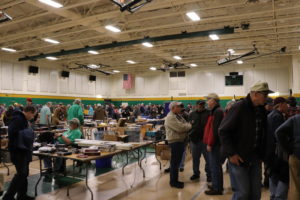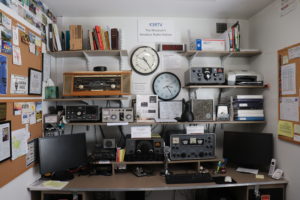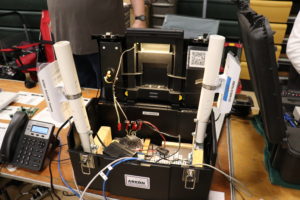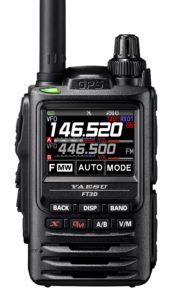One of the responsibilities of the Technical Coordinator in the Ohio Section is to submit something for the Section Journal. The Section Journal covers Amateur Radio related things happening in and around the ARRL Ohio Section. It is published by the Section Manager Scott – N8SY and articles are submitted by cabinet members.
Once my article is published in the Journal, I will also make it available on my site with a link to the published edition.
You can receive the Journal and other Ohio Section news by joining the mailing list Scott has setup. You do not need to be a member of the ARRL, Ohio Section, or even a ham to join the mailing list. Please sign up!
If you are an ARRL member and reside in the Ohio Section, update your mailing preferences to receive Ohio Section news in your inbox. Those residing outside the section will need to use the mailing list link above.
Updating your ARRL profile will deliver news from the section where you reside (if the leadership chooses to use this method).
Go to www.arrl.org and logon.
Click Edit your Profile.
You will be taken to the Edit Your Profile page. On the first tab Edit Info, verify your Email address is correct.
Click the Edit Email Subscriptions tab.
Check the News and information from your Division Director and Section Manager box.
Click Save.
Now without further ado…
Read the full edition at:
THE TECHNICAL COORDINATOR
Jeff Kopcak – TC
k8jtk@arrl.net
Back in January of 2017, I wrote an article published in the OSJ that talked about different sources of repeater and frequency information. A couple things have changed since it was published. The ARRL no longer prints a pocket-sized directory, much to the chagrin of my dad, and prices have gone up. There is still no great source for the most current list of repeaters. The workplace required me to do some traveling earlier this year to D.C. and Dallas. The D.C. tip was going to allow for much more hamming it up time because I was driving and it was a two-week trip. Dallas required long working days so I wasn’t sure how much radio time I would have but I took an HT anyway. These trips gave me a chance to review different sources of repeater data.
For D.C., I took my HTs along with the gear I typically pack for a public service event where I’ll be riding in someone else’s vehicle. It’s pretty basic consisting of a mag-mount antenna, ICOM IC-2820H dual-band radio with D-STAR, and adapter to go from the radio’s power plug to a cigarette lighter. I take a couple extension cables: coax extension with PL-259s and a barrel connector in case the antenna coax is not long enough. I also take the remote mount cable for the display head just in case.
The cigarette lighter car adapter is more than good enough to power the radio especially when listening more than transceiving. I checked the manual, and verified on an amp meter, the highest power setting (50W) draws about 12-13 amps. Most car adapters are rated at 10A so I’m limited to low or medium power. Components of the typical car adapter are flimsy and drawing anywhere near 10A, or more if the line is fused higher, for a sustained period of time could cause failure or even fire. Low power (5W) draws 4A and medium power (15W) is about 7A (a little less on 2m). One thing that has surprised me, no reports of alternator whine where I’ve used this VHF/UHF setup.

Traveling to and from D.C. and to any new area, I use the band scan memories or scan edge memories. To me it’s easier than making banks of repeaters for different cities along the way. Scan edges are memories available on most modern radios. Set the start and end frequency and the radio scans frequencies in-between, stopping on any signals received. Once it hits the end frequency, returns back to the start frequency and begins scanning again. Often notated “xA/xB,” “xL/xU,” or similar memory locations for beginning and ending frequencies respectively. The 2820 is capable of dual band operation (2 frequencies at once). On the left side of the radio I had a scan starting with 144.000, and ending at 148.000 which covers the 2m band. On the right side was 440.000 – 450.000 for the 70cm band. The “step” setting determines frequency increments. A setting of 15.0 kHz will start on 144.000. The next frequency scanned will be 144.015, then 144.030, 144.045, and so on. A step of 5.0 kHz will start on 144.000, then 144.005, 144.010, 144.015, etc. Most 2m band plans are 15 kHz steps and most 440 are 25 kHz. I stick with those frequency steps. Setting the step to 5 kHz catches more frequencies in cases where a repeater might be coordinated on a non-standard frequency, but it does take much longer to scan and it will stop on a lot more interference from the car or near-by transmitters.
In this day and age, noise will be an issue and the scan will stop frequently. This can be reduced by turning up the squelch or attenuator, but you’ll miss weaker signals. Some radios have a ‘skip’ (sometimes called “lock-out”) function that will skip over problematic frequencies. I use the radio’s “scan resume conditions” to resume scanning 10 seconds after arriving on a signal. This is nice so I don’t have to keep messing around with the radio while driving. If there is an interesting conversation, I have to stop the scan in order for the radio to stay on that frequency.
I use RepeaterBook almost exclusively for downloading repeater lists at home and places I’m staying on the road. The search is straight forward but I do massage the data. I start off with a Location search with a radius of 50 miles. 50 miles is good if you want to hear distant repeaters or driving around the area. A radius of 25 miles is sufficient if you’re staying in or around one city. I export that to CSV (a portability format in plain text for databases, separating the fields by commas) and open in Excel removing anything the radios can’t receive. ATV repeaters, P25, NXDN, 900 Mhz – all get removed. The ICOM radios will get analog and D-STAR repeaters, but not Fusion or DMR. The Fusion radios get Fusion repeaters, not D-STAR or DMR. Then use RT Systems to import the modified CSV for each radio, save it in RT’s file format, and finally download data to the radio. There are entries in RepeaterBook that haven’t been updated so an analog repeater which is now DMR will slip through, for example. I remove those from the RT file later and download again if necessary. I generally don’t spend time writing a DMR code plug while traveling. I don’t find much benefit in researching repeaters static and PTT talk groups for use over a short period of time. If I don’t find a code plug browsing a couple club sites in the area, I use a hotspot.
For some reason, the RFinder application was not loading any data during most of my time in D.C. There was a fix which corrected that toward the end of the trip. I found the website of the local coordinating body for D.C. and Northern Virginia, T-MARC. The website looks like a callback to 1995 but it had information I found interesting including recent coordination actions, detailed interference FAQ, policies, band plans (including digital voice), and updated frequency lists. It should really come as no surprise because the president is a guy that did a lot of good for the Cleveland area before moving to Maryland, Dave – W8AJR. What does our repeater council website have? Complaints the ARRL is not using their repeater data anymore and the 2016/2017 Ohio Repeater Directory!

When looking for things to do during downtime in D.C., I discovered they had a Radio and Television museum. It was something I wanted to see because I did television production in high school and professionally in college. The National Capital Radio & Television Museum was located in a converted house. I walked in and you’re standing in a side room welcoming area, library, and gift shop. I immediately notice a SignaLink and some ham radio gear. There was a bulletin board with ham call signs next to the station. I asked the docent if he was a ham. He wasn’t but the guy in charge was the station Trustee of K3RTV and would arrive a little later. The museum had a couple of pieces from Ohio, KYW pictures and “newspaper delivered by radio” in 1939 from WLW. I hung around and talked to station Trustee Jim – N3ADF after perusing the exhibits. The museum gives him another place to operate radio in addition to another workshop. The club station at the museum does operate a couple special event stations. I’ll be looking for them on the air.
On the way back from the museum, a QSO revealed there was a hamfest coming up that weekend in Virginia. I attended the Vienna Wireless Society’s Winterfest held at Northern Virginia Community College. If you’ve ever been to NOARSfest in Elyria at Lorain County Community College, it was very similar. Outdoor and indoor flea market areas and catering provided by the college. I was happy I attended because of a couple deomonstration tables that were setup. The NoVA ARDEN Mesh (Northern VirginiA) group had nodes setup demonstrating capabilities of the network including phone and video. That area of Virginia has a lot of datacenters. AOL used to be headquartered with 3 datacenters in that area. It was good talking to those guys who could give me more of a deep-dive into technologies used on the networking side. As I’m talking to the mesh guys, I look over at this guy talking about Winlink. He looks familiar but I can’t place why. I figured it out a little while later. If you go to YouTube and search “winlink” he is the first video you’ll see. It was Greg – KW6GB whose video I had seen doing research for a Winlink writeup. I talked to him for awhile and I’m participating in his Winlink Wednesday.
In Dallas, I knew we were going to be putting in long days and since we were flying, I didn’t want to be hassled bringing ham radio equipment by TSA. I did some research and most of the comments read: ‘keep a copy of your license’ which I always have, ‘keep batteries in your carryon’ this is regulation especially for any Lithium-Ion batteries which have been known to explode in checked baggage, ‘it’s unlikely you’ll have a problem.’ This was exactly my experience in both CLE and DFW. I didn’t have large wire antennas or any HF equipment. I can’t say if you’re transporting that type of gear, you’ll have the same experience. Ship it if there is a concern.

As it turned out, I didn’t get any time to play on the radio while in Dallas. One night we did have severe storms roll through. After our work was done, our group made it back to the hotel that night while the ground was dry. Storms were threatening, alot of lightning and weather alerts were popping off. By the time we made it up to our rooms, it was raining sideways.
I was in a hurry to find local Skywarn frequencies and I hadn’t pre-programmed the radio before making the trip. I went to RepeaterBook for Dallas county, 93 repeaters were found. Didn’t have time to sort through or scan for the Skywarn frequency. I remembered something I found and noted in my 2017 article, the RadioReference database has a list of Amateur Radio frequencies for an area. The ones listed tended to be repeaters actually on the air, more popular, Emcomm, and Skywarn type repeaters. Sure enough, tuning into 146.880, the first frequency on that list was the Dallas RACES and Skywarn net. The storms blew through with no major events. More like the storms experienced on Thursday night/early Friday morning at Dayton this year. Lotta rain, flooding, and some damage depending on location.
For some reason, this new location for Hamvention and lodging is prime area for thunderstorms. Fine by me. I love a lightning show and it has become a highlight every year to see storms roll through. Sometimes they roll through during the show which wasn’t so neat. This year they seemed to happen before and after the show which was perfect. There seemed to be more people attending Hamvention which was probably attributed to the dryer weather. My dad and I spent most of our time in the flea market since it was sunny and dry. Sunscreen was a requirement otherwise you were going to be toasted. I usually don’t need sunscreen on my legs but even the backs got a little burned.
My dad and I had some excitement the first night at the hotel. About 4:30am Friday morning, all were woken up by the sound of the fire alarm. Just after being awakened, I heard thunderstorms outside. At that point, I hoped it was a false alarm and would cease before we left our rooms. While in Dallas, the fire alarm went off but it stopped 20 seconds later in the early morning. Enough to be annoying but I was now 2/2 over my last two hotel stays where the fire alarm sounded. Got dressed and left our room with everyone else. The alarm panel was showing smoke detected in the pool maintenance room. A large awning provided shelter from the storm, pouring hard but not blowing. Waited there 15 minutes or so while the fire department showed up with two firefighters. The hotel staff couldn’t get in the pool maintenance room. They finally shut off the alarm but we had to wait in the lobby. Another 40 minutes later we could return to our rooms but they couldn’t get the fire alarm to reset. That pretty much set the tone for the weekend at this hotel. *Insert Circus theme music here*

At Hamvention, Yaesu was showing off a demo unit of their new Fusion HT. The FT3DR is the same as the FT2DR though a little smaller, more like the size of the FT-70DR, with a color screen and Bluetooth. Elecraft had a demo of their K4. Seems a little higher in price than other SDR radios but those who have them swear by ’em. It’s cool that it’s running Linux because many other SDR radios have been running and require Windows.
Probably the biggest news came in the Ham Nation wrap-up of Hamvention. It maybe answers the question, what happened to Mendelsons? They had the biggest tent in the flea market when the show was at Hara Arena with loads of surplus gear. Since the switch to Xenia, I think they were there in some corner one year. George – W5JDX went to visit the store location and found out they are planning to close the store. They maybe still around for visitors of Hamvention 2020 but sounded like they might be closed by next year. George shot some video but hasn’t edited it yet. It will probably appear on Ham Nation or his other show, Amateur Logic. Sad to see another Hamvention vendor go!
Thanks for reading and 73… de Jeff – K8JTK
